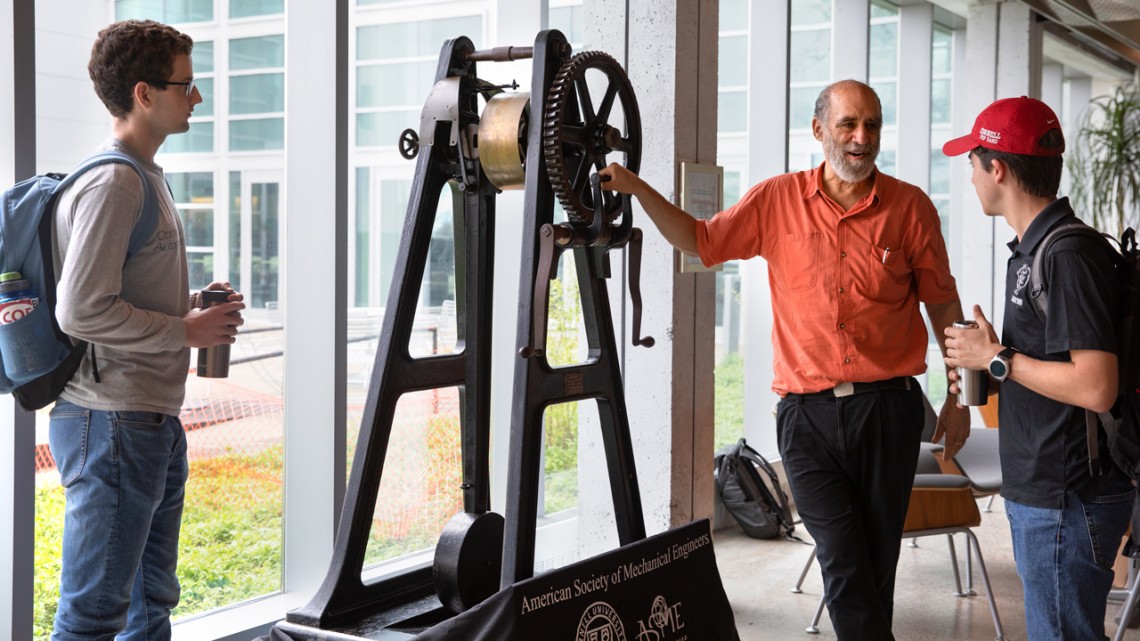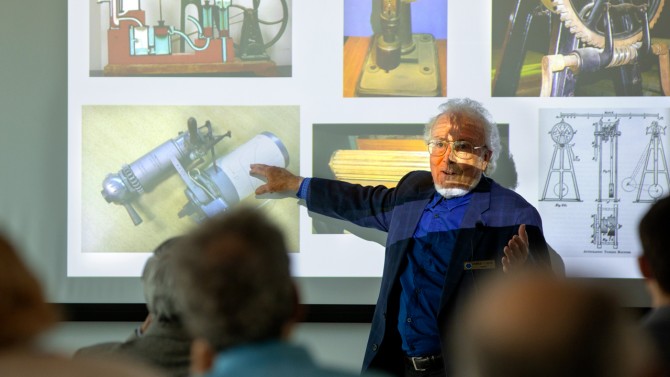
The autographic testing machine created by Robert H. Thurston to test the elastic limit of steel and wrought iron is one of the machines that is part of the newly designated Mechanical Engineering Heritage Collection in Upson Hall.
Heritage collection honors Thurston’s engineering excellence
By Matt Hayes
Perhaps no one person has influenced engineering education in the United States more than Robert H. Thurston.
A visionary 19th-century academic and innovator whose contributions helped usher mechanical engineering into the modern era, Thurston took a small, disorganized engineering school at Cornell and turned it into the largest and most prominent mechanical engineering program in the country.
Honoring his pioneering work as an engineer and educator, the American Society of Mechanical Engineers (ASME) designated the Robert H. Thurston collection as a Mechanical Engineering Heritage Collection at a ceremony May 3 in Upson Hall.
“He set the standard for engineering education with a holistic approach that combined science, mathematics, design, shop experience and laboratory testing of both materials and larger engineering systems,” said Said Jahanmir, ASME president. “This collection and Thurston’s work at Cornell represent an important milestone in engineering.”
The collection of 16 artifacts is housed in display cases in Thurston and Upson halls. The collection includes machines he designed and patented, working models he built, his personal letters and books, and a bas-relief portrait sculpted by artist Hermon Atkins McNeil that hangs in the entrance of Thurston Hall.
Thurston was already a renowned engineer when Andrew Dickson White recruited him to lead Cornell’s Sibley College in 1885. At the time there were about 60 students enrolled and rampant dissatisfaction about the direction of the program. Thurston toughened entrance requirements, hired new faculty and expanded contacts with industry. Increased attention to science and math made the curriculum more rigorous.
He also developed a concept that would change engineering education forever: the testing laboratory.
“The idea that in education and engineering, you have to test materials and machines before offering them to the public – this was a real achievement,” said Francis Moon, Ph.D. ’67, the Joseph C. Ford Professor of Engineering Emeritus.
Thurston modernized the curriculum and focused education on the classroom and laboratory rather than the machine shop. His work merged classroom teaching with hands-on learning, and he added courses in the emerging field of electrical engineering. By the time Thurston died in 1903, nearly 1,000 students were being educated by 40 faculty in seven departments. In 1909, the college accounted for 44% of the university’s enrollment.
“He elevated the role of the laboratory and the training of engineers, and integrated basic science with shop training,” said Julia Thom-Levy, vice provost for academic innovation.
As an inventor, his work in engineering science advanced knowledge about steam power and more efficient machines. One of his inventions was the autographic testing machine.
“It’s a reminder that all innovation has a basis somewhere,” Bhavi Jagatia ’19, president of the ASME Cornell student section, said of the device in the collection used to test the elastic limit of steel and wrought iron. “The machines he invented were the primary method to understanding what we do now.”
Herman Viegas, chair of the ASME History and Heritage Committee, said the landmark status asserts the importance mechanical engineers played in meeting societal and technical challenges.
“Too often today, mechanical engineering achievements, even monumental ones, go unnoticed,” he said. “There’s something taken for granted as part of modern life … for the tremendous amount of skilled design work and creative genius that went into it.”
Media Contact
Get Cornell news delivered right to your inbox.
Subscribe

